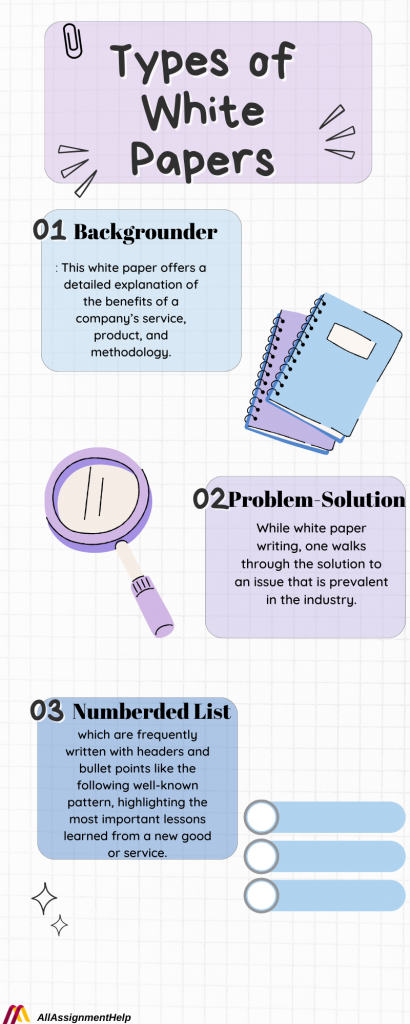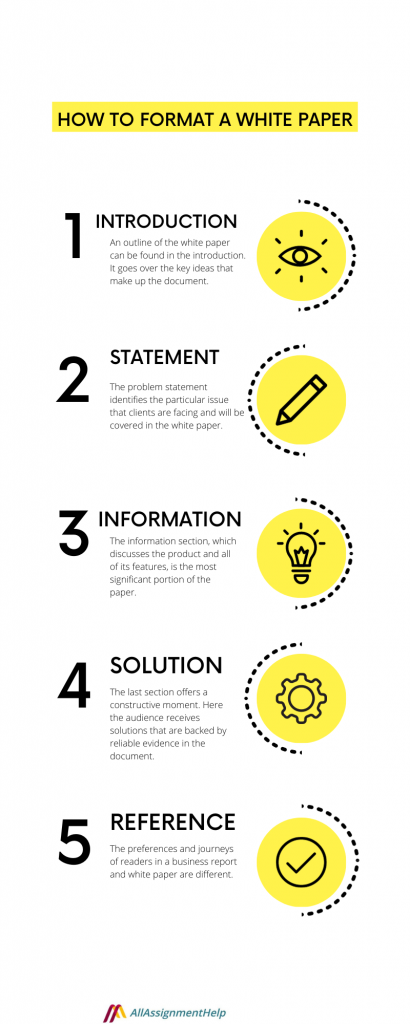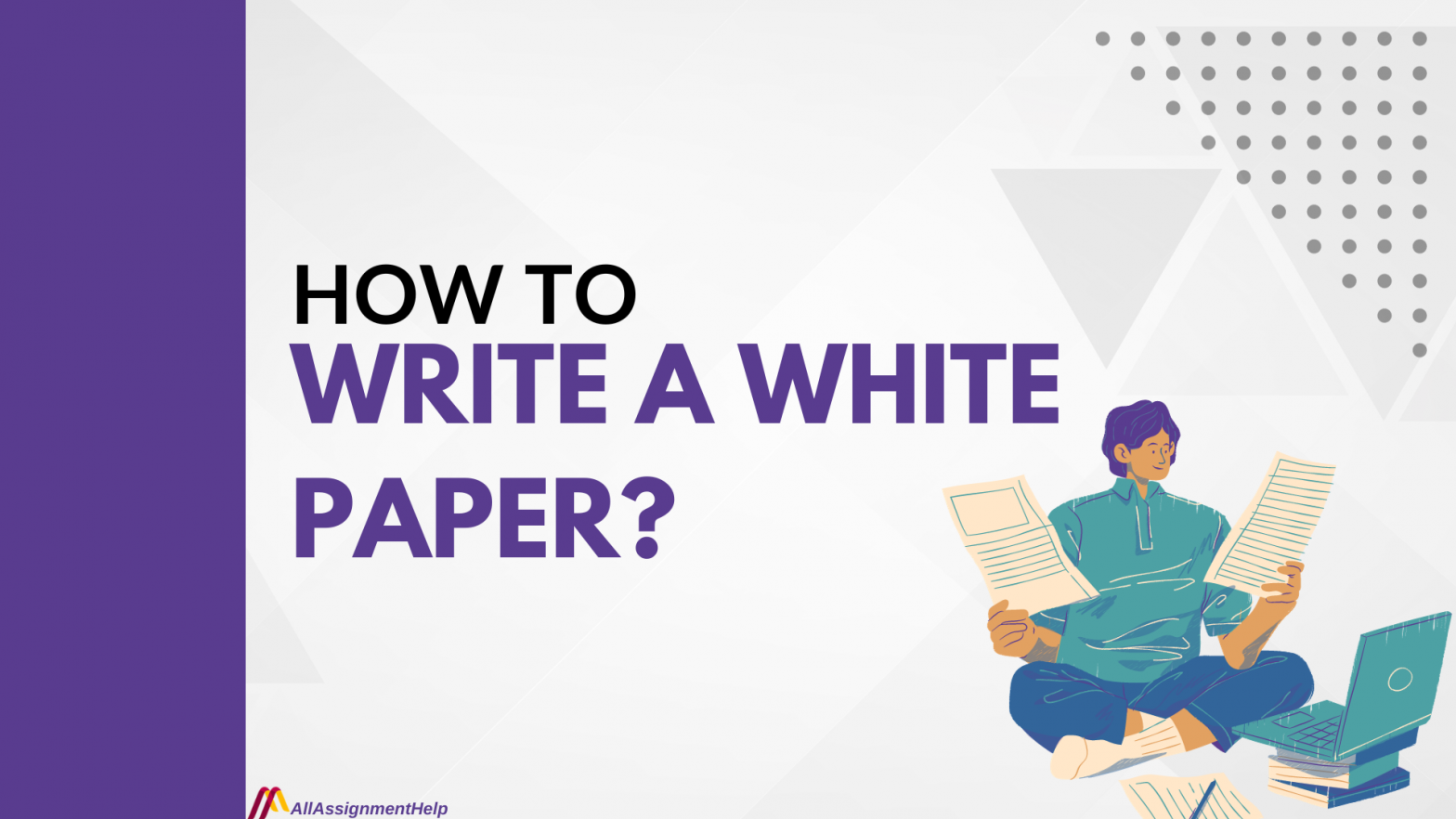Table of Contents
Publishing insightful and worthwhile content is a tried-and-true method for organizations to build innovative thinking and increase authority in their industry. Using a white paper is one of the best ways to accomplish it. So are you all set to write a white paper? This blog post which is curated by an expert at allassignmenthelp.com can assist you with creating a white paper if you are still getting ready and looking for strategies to gather a company’s in-depth market expertise and deliver it to your users.
If you are eager to know all these things, go ahead:
What Is A White Paper?
A white paper is an in-depth manual or analysis of a specific subject and its issues. Its purpose is to educate and enlighten the reader about the subject, its issues, and potential solutions.
Although this was a basic explanation, a formal one according to the marketing industry would be as follows:
A white paper is an extensively investigated report on a particular topic which provides an answer to an industrial issue. Usually, a firm writes it to demonstrate their knowledge and experience with facts and proof; yet, it shouldn’t promote or advertise the company’s goods.
A white paper is a piece of content resembling an eBook. Opinions and facts included in white papers are supported by research and statistics derived from reliable sources.They include visuals as well, such as tables, images, graphs, charts, and many more. The white paper writing is generally longer, detailed, and technical than an eBook.
Read Also- How to Ace an Effective Virtual Classroom Training Session?
Backstory of White Paper
The term “white papers” traces its origin in England’s government-issued documents. One of the widely popular examples is the Churchill White Paper, 1922, which was commissioned by Winston Churchill.
In businesses, especially in B2B, consulting, financial, sectors, white papers are used for communicating the philosophy of a company on a certain topic. It makes the case for the goodness of their product.
White papers can be considered as an editorial than other forms of content. It has a deep foundation of research which gives it an authoritative tone. This is the reason why they promote thought leadership.
What Is The Use of White Paper?
A white paper demonstrates the authority and knowledge that an individual or organization possesses in their particular field. Its goal is to convince readers that a certain approach to an issue is the best one by carefully examining the available data and supporting arguments. In addition, it shows readers that the author (or organization) of the white paper is a reputable authority in the industry.
Businesses prepare white papers with two major intentions:
- To record expertise
- To market themselves
They are dedicated to an audience outside the range of business. This is why they act as a medium to attract new readers to the company as potential consumers by providing them with industry knowledge.
Every writer must know that white papers can never be a sales pitch. They are written in an entirely different way. Yes, they both serve a purpose to sell the company, but white papers don’t market typically. They highlight the expertise of the business by highlighting valuable recommendations and the internal expertise of the company. Unlike sales pitch, they don’t bid for the business.
Examples:
- White Paper: Online Advertising: Making marketing cheap yet effective
- Sales Pitch: How XYZ marketing is saving users’ budget on advertising?
You may find it difficult because it takes much study and understanding. As an MBA student, you need to be proficient in writing white papers. We encounter a lot of students who find it so complicated that they wonder if can I have someone to take my online course? It is crucial that you get professional help if this is also terrible to you. If you give up now, you will never have the chance to take advantage of the opportunities you can present to your company. Therefore, you can look for professionals online to assist you in reducing your writing stress and improving your ability to stay focused.
Read Also- How to boost your career through online classes?
Types of White Papers
White papers are used differently by government agencies, big corporations, and startups. White papers come in three primary categories: problem/solution white papers, numbered lists, and backgrounders.

- Backgrounder: This white paper offers a detailed explanation of the benefits of a company’s service, product, and methodology.
- Problem-Solution Approach: While white paper writing, one walks through the solution to an issue that is prevalent in the industry.
- Numbered lists: which are frequently written with headers and bullet points like the following well-known pattern, highlight the most important lessons learned from a new good or service:
If you are a student and willing to know about other white papers, you can get online assignment help. Experts in such sites can let you know about them in a very good manner. Also, they will teach you some basics which help you in writing better content.
For a white paper, who is the intended audience?
White papers are created for readers who are not involved in the industry. A white paper aims to offer trustworthy knowledge, experience, and counsel through reliable research and reasoning, since readers may already be somewhat familiar with the subject or may be interested in learning more about the market before deciding on a good or service.
How to select a white paper topic?
It is tough to choose the right kind of topic. Here are the three factors you can consider while choosing a topic:
- Audience: Keep your target audience in mind. Try to ascertain their preferences.
- Expertise: While writing a white paper you must highlight the expertise of your business.
- Problem-based: Address a specific problem related to your business or industry.
- Solution-focused: It should have a proposed solution or recommend a solution to the problem.
How to Prepare for White Paper Writing
A good white paper can be written by adhering to the guidelines listed below, which are necessary to write a white paper. If none of this helps, you can always seek the guidance of professional writers; they will simplify the process for you.
Research
A white paper topic has to be researched comprehensively. You can dig for information from industry resources, online references, and internal documents.
You don’t have to follow any stern rules on citations, however, do cite data that you didn’t know prior to research. But, try to know the readers’ confidence is expected to grow with a big list of resources.
All your sources must belong to authoritative websites. To make a valuable document, you will have to cite credible origins. Also, you can take help with custom research paper writing. These services provide assistance that is specifically tailored to meet your needs.
Read white papers
It is always a good idea to read others’ work before writing your own. By doing so, you can gain ideas on how to make your content more engaging. Also, you can decide on things you don’t want to include in your piece of writing.
So, find out white papers written on your topic on the web. Go through them and determine the knowledge gaps you have. Use your reading skill as an opportunity to create existing content.
Go for organizational tools
Isn’t it great to keep track of all sources, content, and ideas involved while writing a white paper? By using an organization tool like Mind-Map, you can do this easily. Such tools allow the writer to connect multiple pieces of information into one visual overview.
There is no need to spend extra bucks to access an organizer. You can use free tools like FreeMind which are simple to use.
Read Also- how to focus on homework? Best Tips to know.
How to Format a White Paper?
The white paper format is generally a standard document. The order of content is often similar to other business documents, but the major difference is:

1. Introduction
An outline of the white paper can be found in the introduction. It goes over the key ideas that make up the document. Additionally, it aids the client in determining whether the report’s contents apply to them.
2. Statement of the problem
The problem statement identifies the particular issue that clients are facing and will be covered in the white paper. The statement ought to be compatible with the good or service. It must also be stated clearly.
3. Information
The information section, which discusses the product and all of its features, is the most significant portion of the paper. It integrates the issue statement and introduction. The data will result in a resolution.
4. Solution
The last section offers a constructive moment. Here the audience receives solutions that are backed by reliable evidence in the document.
5. Reference
The preferences and journeys of readers in a business report and white paper are different. The major findings follow suit. In case you are not sure of distinctions and lack business writing skills, you can connect to some online report writers.
Irrespective of the journey, your document must be easy to read and understand. It must have informative headings and overall easy navigation.
Here are the basics for drafting all sections:
Title
It must be appealing as users are more likely to click on catchy titles than plain, boring ones. You can say, it is crucial to think of a good title. Try to clearly say what readers will get in your content. Entice them with your title.
Don’t use the phrase “white paper” in the title unless required. It has been observed that the audience seek authoritative indicator. Understand the preferences of your potential readers.
Abstract
This section is picked by most of the users. It gives a brief overview of the major points of a white paper. Here, the readers are allowed to acknowledge they have found a relevant document to serve their needs. After going through abstracts they must feel they are in the right place.
Problem Statement
The problem statement explains the problem your white paper is mainly addressing. The main issue has to be defined and put into context. This has to ensure readers understand the problem.
Background
In this section, you will have to offer background information needed for the readers. Your readers should be able to grasp the issue and solution.
The contents of the background must be detailed, high-level, broad, and technical. It must depend on the reader and the problem.
When original research is done for a white paper, you must communicate the methods.
Solution
Here comes the most sorted moment of white paper writing.
On the basis of the preceding data, you will have to present the solution here. It must be argued and developed for the use of aggregated evidence and expertise of the author and their company.
Conclusion
You may already know what the conclusion is meant for. Summarize the content of the major findings of your white paper. Present recommendations based on solutions provided.
References
All sources are utilized to develop a white paper which should be aggregated and cited here. References add validity to your white paper. This is the only section where your readers get content for further research. Follow citation formats like MLA or APA. Create it as per your industry
What Not to Do While Preparing A White Paper?
Knowing everything about white paper is good if you are a beginner. But before you begin with one, there are certain mistakes you must know so that you can avoid them.
There are some common mistakes listed here. All of them have the potential to turn your effort and dedication into a wasted venture. Let us quickly go through them:
Make it like a sales pitch
Yes, white papers are used in marketing campaigns where businesses present their products and services. But that does not mean it should look like a sales pitch. If you are turning a white paper into a sales pitch, you are taking it all wrong. This will instantly turn your readers off. Because, when the audience comes to white papers in search of informative pieces made without any bias. Thus, it should help them by providing information and not try to persuade them to buy a service or product. A sales pitch is a different concept, you can save it for product brochures or other content.
Lack of in-depth research
You have already read that white papers must be intensely researched documents. It is right that carrying out valuable authentic research requires a lot. Apt research often needs collective efforts. At times it may fall beyond the budget of a marketing team, and minor statistics from the first page of a simple Google search will not do any good.
Lengthy research is often time-consuming. Searching through a number of scholarly works and collecting relevant statistics will surely take time, but the results will be worth your effort. If you want your white paper to have an intended effect, establish your content as an authoritative source. A source to which your users can trust won’t return. In any case, don’t compromise with research.
Read Also- Journey of Bill Gates
Not-so-good design
The design of white paper is a broad concept to discuss. Though we cannot elaborate much here, it’s worth a brief mention. All writers, newbies, or pros must focus on the written content of the white paper, it matters a lot. But if one is neglecting design, even the perfect content will go unnoticed. Not putting effort into creating stellar designs can harm your white paper to a great length. On the other hand, a good design can make your salient points stand out. Your readers will easily understand what is presented in the paper. Visuals like videos, charts, images, and graphs supporting your argument are important. You can search on the internet how people make efficient use of visuals in design.
Keeping it vague
White papers do hidden marketing. They serve a purpose to offer facts and information without directly persuading them. But, the essence remains in attracting potential consumers. To drive people towards a brand, white papers must not be boring. Don’t make it vague.
Try telling a story. Problem-solutions papers, backgrounders, and research findings, all have some story. Make your readers aware of these stories through your narrative. Because they cannot make it via the whole piece if there is nothing to keep them connected. Set a problem, and discuss its solution. Involve some success stories, it’s a proven formula to create engaging content.
Keeping it abstract
Because most white papers will involve sharing research findings, it can be easy to leave them in the realm of theory without explaining how to utilize those findings on a practical level. This is more of backgrounders but can also be the case with problem-solution white papers.
Generally, white papers present and share research findings. It is very important to keep them in the reign of theory. You don’t need to describe how to use the research findings in the real world.
Takeaway
Preparing a perfect white paper is not a 2-minute job. Time, skill, and effort are the key ingredients you need to create a valuable and appealing document. When you are making something to share a company’s essence, knowledge, contribution to the welfare of society, role in the industry, you must focus on all the four pillars of a white paper: research, format, design, and content. One stellar white paper can increase business opportunities to a great extent.
FAQs
| What distinguishes a case study from a white paper? Recognizing the Distinctions Essentially, a case study and a white paper both explain the advantages of a specific invention, product, or service while showing how a specific approach has worked to solve the issue. |
| What is the lifespan of a white paper? A white paper usually needs to be revised every one to two years, though this can vary by business. |
